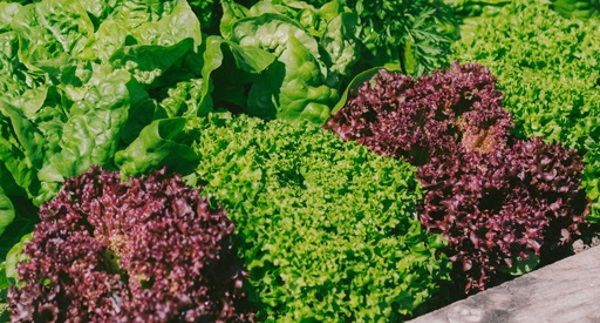
5 Steps to Lettuce Success
- Pick a variety based on the type of lettuce you like to eat.
- Choose a sunny spot and prepare your soil well with organic matter like compost and sheep pellets.
- Add a layer of vegetable mix to plant into. Lettuce can generally be grown year-round in New Zealand.
- Feed every four weeks during key growth periods with vegetable food for plenty of leafy growth.
- Add a layer of mulch and keep your lettuce well watered.
Follow our full guide below for a bumper crop of homegrown lettuce.
Lettuce is the quintessential salad crop and can be grown by anyone. Even if you don’t have a garden or much space, a kitchen bucket or flexi tub is big enough to produce a plant or two.
Lettuces come in a wide range of colours, shapes, sizes and types, and sometimes the most challenging part of growing them is deciding which ones to plant.
Prepare
The best advice on what variety of lettuce to grow is what you normally like to eat. There are two main types of lettuce; hearting lettuces, which have a dense centre, and loose-leaf lettuces, which have open leaves and no heart.
Lettuces require full sun, plant them in soil that is rich in compost and make sure the soil drains quickly as they dislike having wet feet for any length of time.
If you don't have much space, lettuce can easily be grown in pots, containers and planters.
Shop Tui Lettuce Seeds - Cut & Come Again, Great Lakes and Gourmet Blend Mixed.
Plant
Like building a house a good foundation is the key to success in your garden. The better the soil, the better your plants will grow.
If you are starting with an existing garden bed dig in organic matter like Tui Sheep Pellets and Tui Compost to your soil. Then you can add a layer of Tui Vegetable Mix. If planting in pots and containers, fill with Tui Vegetable Mix.
The best times to plant are early in the morning or late in the day, so the plants aren’t exposed to the hot sun straight away. Always water plants well before and after planting.
Planting in garden beds
- Water plants thoroughly before planting and allow to drain.
- Dig a hole, approximately twice the depth and width of the root ball of your plant.
- Partly fill the hole with Tui Vegetable Mix.
- Gently loosen the root ball of your plant and position the plant in the centre of the hole.
- Fill in with Tui Vegetable Mix.
- Press soil gently around the base of the plant.
- Water your plant well.
Planting in pots and containers
- Water plants thoroughly before potting and allow to drain.
- Partly fill your container with Tui Vegetable Mix.
- Gently loosen the root ball of your plant and position the plant in the container.
- Fill your container with Tui Vegetable Mix up to 3cm from the top.
- Tap the container gently on the ground to settle the mix.
- Press soil gently around the base of the plant.
- Water your plant well.
With lettuce you can harvest a leaf at a time, and they will regrow. If you start picking leaves early enough and leave enough of the plant in the ground, you should be able to harvest for a number of weeks.
Nourish
Feed your lettuce plants and they will feed you. Plants use nutrients from the soil as they grow, so replenishing the nutrients ensures your plants grow to their full potential.
Select a fertiliser specially blended for your crop like Tui Vegetable Food. Feed lettuce planted in pots and containers with Tui NovaTec Premium fertiliser. Well watered, well nourished lettuce will have a better chance of keeping insect pests and diseases at bay. While your lettuce are growing regularly apply a dose of Tui Organic Seaweed Plant Tonic to give them a welcome boost.
Protect your plants from the elements with layers of Tui Pea Straw Mulch, to help keep their roots moist and keep your garden weed free.
Be vigilant and stop unwanted insects and diseases from ruining your plants. Slugs and snails can be an issue - lay Tui Quash slug and snail control around young plants.